After a few days mixing writing work with exploring Gdansk, I still had five days to spare. So I took a train to Berlin. I had no plan, but I had a bike, which is all you need. This post covers those five days.
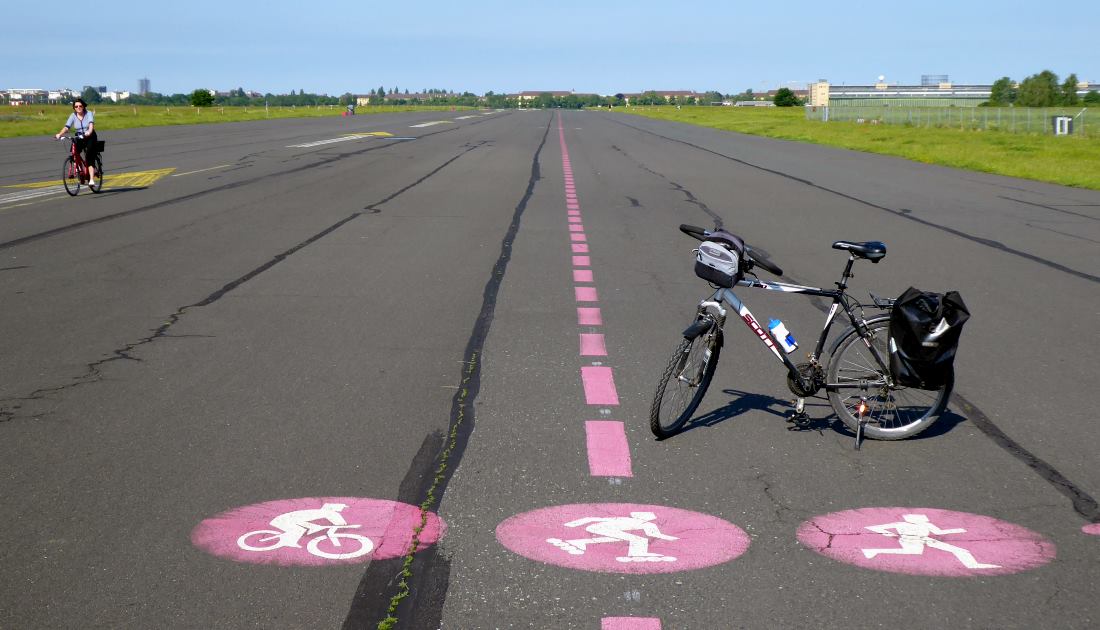
The first morning I cycled across Tempelhof, on possibly the world’s widest cycle path (pic). At over 100m from side to side, it’s wider than some Sustrans routes are long. Certainly smoother. It’s probably the only cycle path visible for space. It’s even, as my hardline cycle-campaigner chums might describe it, almost wide enough.
The mighty breadth is down to its being a runway. Tempelhof was an international airport (the destination of the famous Air Lifts) until its closure in 2008. The entire area is now a vast (and well-used) leisure park, runways, access ways and all. It’s a strange feeling, taxiing along on your bike and turning into the wind ready for take-off.
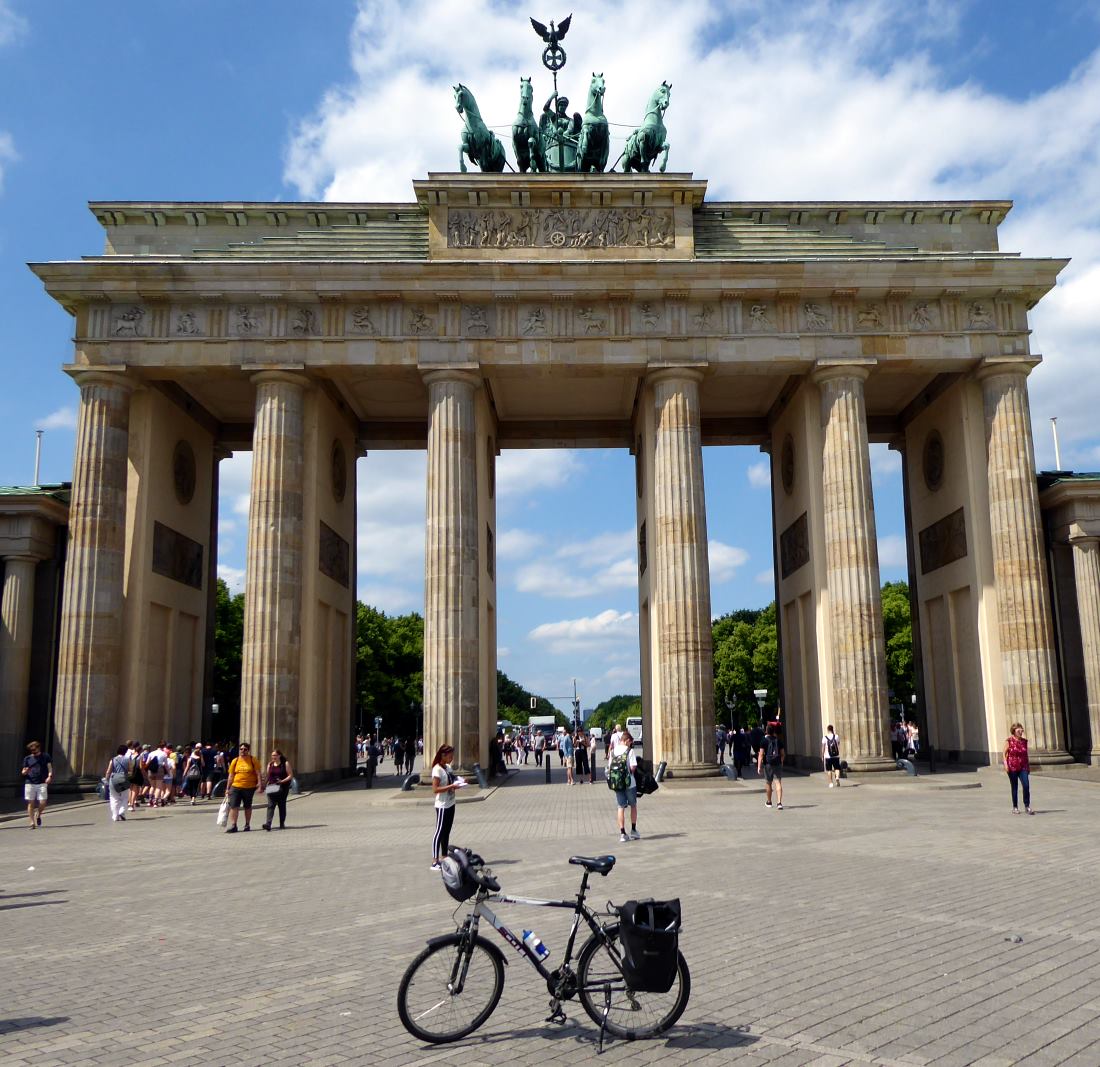 I also collected a few of the postcard sights from the saddle, such as Brandenburg Gate (pic).
I also collected a few of the postcard sights from the saddle, such as Brandenburg Gate (pic).
It’s a focus of national unity – playing a heavily practical and symbolic role through the splitting up and reunification of Germany, for instance – and was the place where the German football team staged their victory ceremony after winning the World Cup in 2014, so obviously there’s no English equivalent.
However, my main project for the stay was to cycle the Berlin Wall Cycle Path. It traces the course of the barrier which separated East and West Berlin from 1961 to 1989, and – astoundingly – it’s just over 100 miles long.
I took three leisurely days to do the route, mindful of maximising my chances of morning kaffee und küchen from Germany’s tempting bakeries. Coming back from the stage ends, and returning the next morning, was easy thanks to Berlin’s underground trains all taking bikes.
Fares were very reasonable, especially as sometimes the ticket machines didn’t work at the non-barriered stations and there was no onboard staff to buy a ticket from.
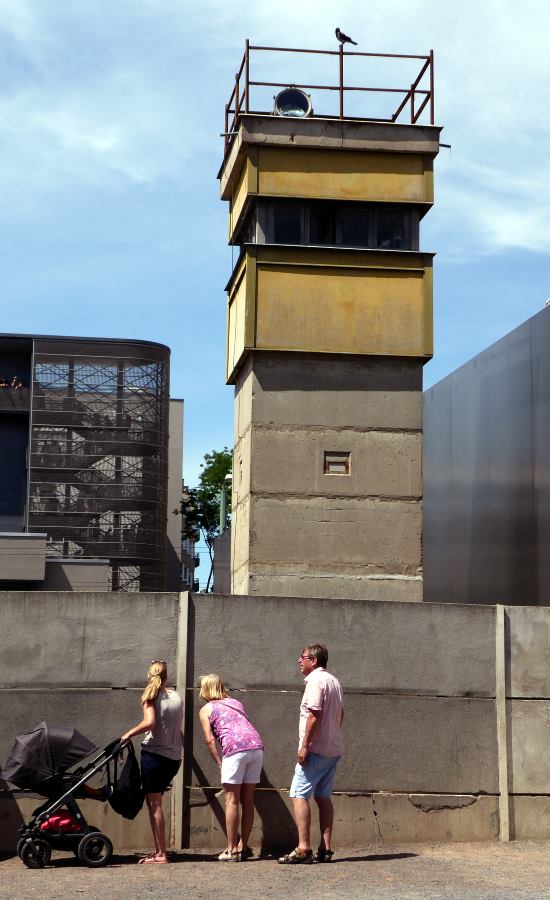 Very few sections of the Wall are left. Some is preserved at the Wall Memorial on Bernauerstrasse, which also has one of the two or three remaining watchtowers (pic).
Very few sections of the Wall are left. Some is preserved at the Wall Memorial on Bernauerstrasse, which also has one of the two or three remaining watchtowers (pic).
It’s hard to think that, for most of my early life, this street was a scene of wretched separation, oppression, and shoot-on-sight paranoia.
About the most traumatic thing that happens here these days is Chinese tourists photobombing your selfies.

The longest stretch remaining is at Mühlenstrasse, called the ‘East Side Gallery’ because of the murals (pic). I liked this one of Karl Marx. Personally I’d have used his witty ‘I wouldn’t want to belong to any club that would have me as a member’.
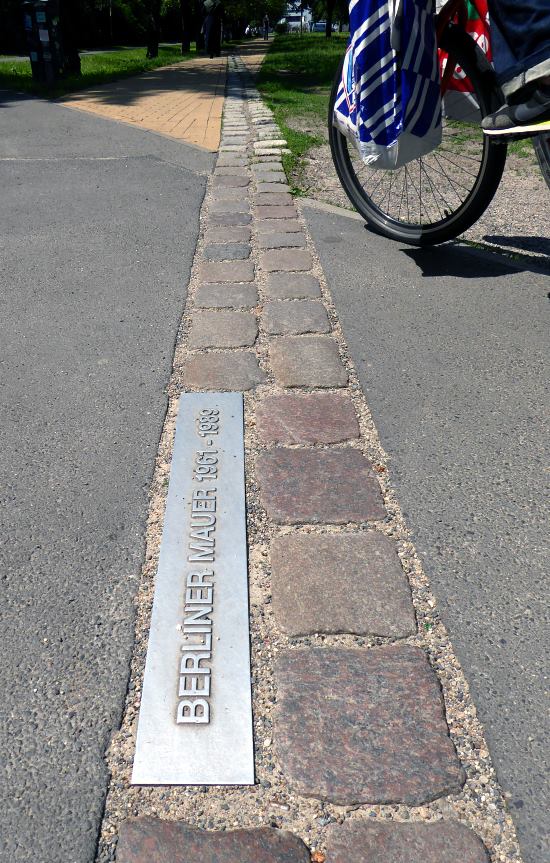 In the urban parts of the Route, the position of the wall is often marked by a double line of bricks (pic).
In the urban parts of the Route, the position of the wall is often marked by a double line of bricks (pic).
But that was only the final obstacle: the ‘wall’ was actually a double wall, consisting of a first fence or wall, then perhaps 100m of flat floodlit ground full of booby traps, trip wires, anti-tank devices, soft earth, upturned spikes, before the final 3m high wall.
The old joke about the East German Pole Vault Champion becoming the West German Pole Vault Champion, though a good gag, wouldn’t quite work in practice.
As soon as the athlete vaulted the first wall, they’d land in the strip, and would have been shot dead by the dozens of guards.
So, not very funny, really.
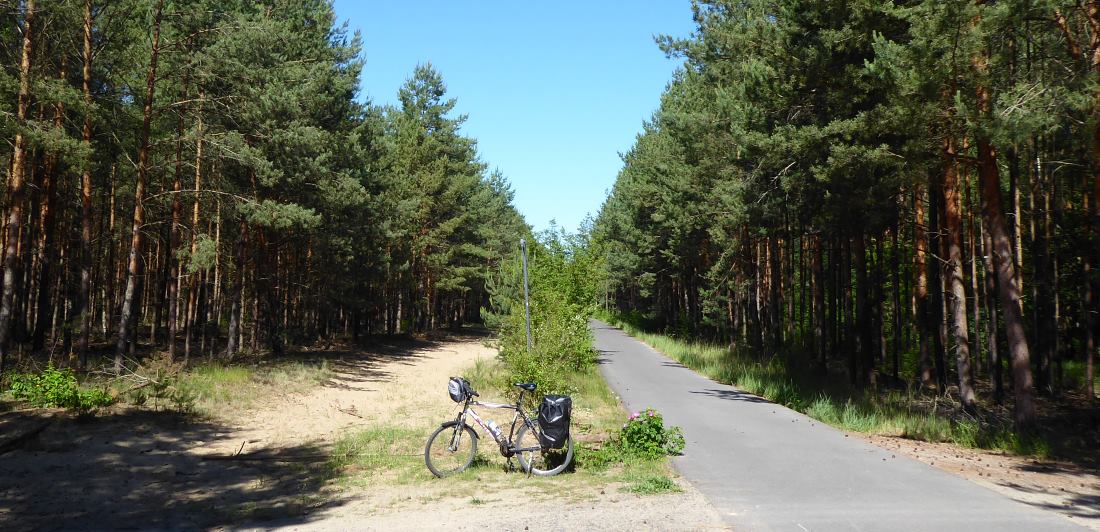
Most of the Wall wound its way through quiet countryside, and you can vividly see where the ‘death strip’ was (pic). For perhaps 80 of the 100 miles, you cycle along flat, smooth tarmac, following the old service road: it’s very much like a railtrail, apart from the 90-degree bends here and there where it had to follow the arbitrarily drawn East-West border.
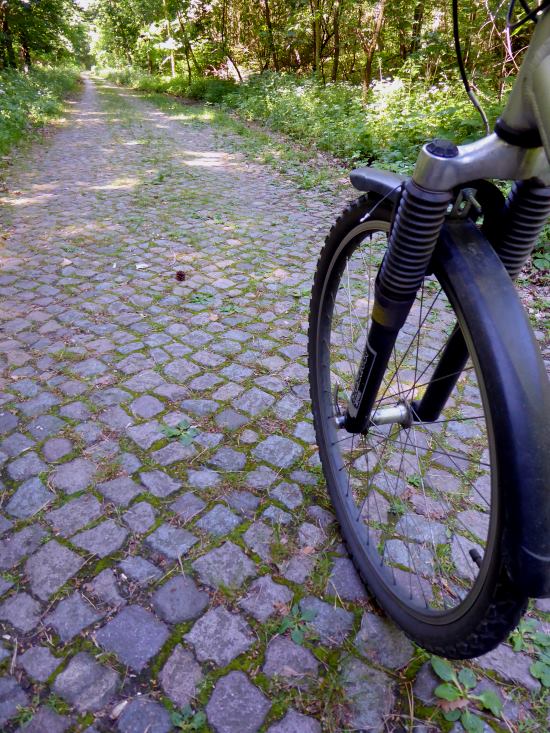 The patrolling GDR soldiers must have been bored out of their minds watching for escapees. At least they had each other.
The patrolling GDR soldiers must have been bored out of their minds watching for escapees. At least they had each other.
To watch, I mean: soldiers tried to escape too. And, in this paranoid dystopia, they were being watched in turn, by secret police.
Add in your networks of paid and unpaid informants, and it seems half the country was spying on itself. No surprise they didn’t get round to tarmacking those patrol roads. In a few places it’s still the original cobbles (pic), and if they could only go as slow as me when they were chasing fugitives, it’s a wonder more didn’t escape.
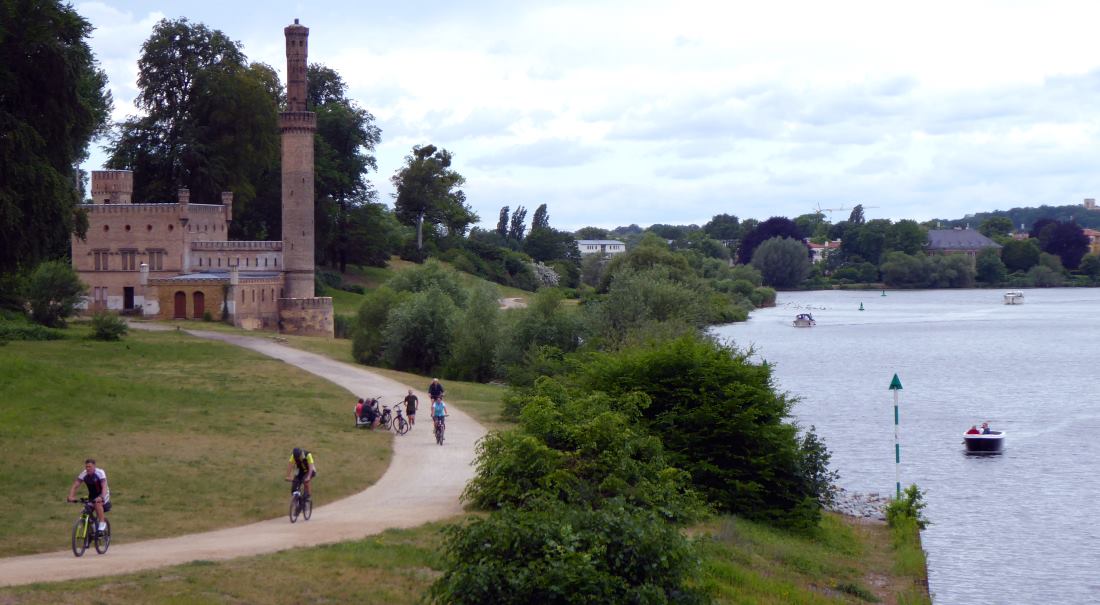
To the south-west, round Potsdam – clearly an agreeable sort of place – the Wall had to wiggle round various lakes (pic).
This is the nicest bit of the whole trail, popular with leisure riders; round here the Wall was sometimes only a few rolls of well-guarded barbed wire, sealing off grand old villa houses in the East from the edge of the lake and its Western water, which must have annoyed those who had a boat out on the jetty that they couldn’t reach.
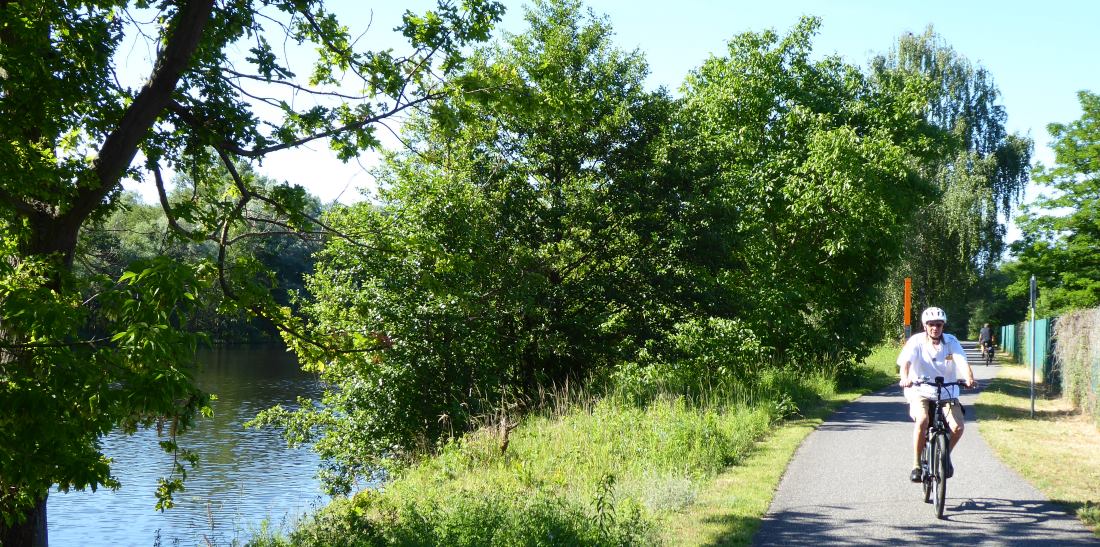
There’s more picturesque waterside cycling along the route north of Spandau (pic). (A whole generation can’t think of that place without mentally adding ‘…Ballet’. I’m not one of that generation.)
This was an utterly delightful part of the route. I was filled with a sense of tranquillity, as well as with coffee and cream cake from a friendly Sunday morning cafe back in the town.
Well, that’s about it for this trip. I have a final day free in Berlin tomorrow, which is just as well, as I have a ton of admin to do before flying back home on Tuesday, so I probably won’t be straying far from the hostel.
I’ve had a wonderful time and many memorable experiences, making my way ‐ with my bike ‐ from Albania, to Montenegro for Tim’s birthday gathering; from there by train and bike through Serbia, Hungary and Slovakia; cycling the Polish End to End; and finishing here in cool, vibrant Berlin, by cycling the Wall Trail.
The trekking bike proved exactly the right choice for the trip, given the range of surfaces I had to cycle over, and made it through everything with no punctures, mechanicals or significant problems.
It may be heavy and slow, it may be stiff and creaking a bit more than it used to, it may be old, cheap and unfashionable, but by gum it works, it’s reliable, and it does the job perfectly well.
Funnily enough, all that applies to me too.